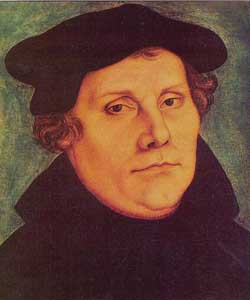NORC survey finds America’s Protestant majority is shrinking
By William HarmsNews Office
 Martin Luther, a German theologian and author, was instrumental in the rise of Protestantism during the 16th century. Tom Smith, Director of the NORC General Social Survey, predicts—based on collected data—that the percentage of the population that is Protestant will likely fall below 50 percent by mid-decade, if not sooner. | |
The increasing secularization of American society has taken a particular toll on Protestant identity, presenting the prospect that after more than 200 years of history, the United States may soon no longer be a majority Protestant country, according to a new study by the National Opinion Research Center.
The percentage of the population that is Protestant has been falling and will likely fall below 50 percent by mid-decade or may already be there, the study showed.
Between 1972 and 1993, the Protestant share of the population remained stable, but then a decline set in. In 1993, 63 percent of Americans were Protestant, but by 2002, the number was 52 percent, the NORC research found. During the same time, the number of people who said they had no religion went up from 9 percent to nearly 14 percent. The survey listed people as Protestant if they indicated they were members of a particular Protestant denomination, such as Baptist, United Methodist or Episcopalian. Membership in many of the Protestant denominations has been declining.
The change is another example of how the country is moving toward becoming a nation of minorities, said Tom Smith, Director of NORC’s General Social Survey, a 32-year-old survey that is widely referenced by social scientists as one of the nation’s most scientifically reliable gauges of public trends. NORC research assistant Seokho Kim, a graduate student in Sociology, co-authored the study, “The Vanishing Protestant Majority.”
The survey shows continual erosion on many measures for Protestants in the past generation, while the proportion of people who report they are Catholic has remained fairly steady at about 25 percent of the population. People who said they belong to other religions, including Eastern faiths and Islam, Orthodox Christianity, interdenominational Christianity, and native-American faiths increased from 3 to 7 percent between 1993 and 2002, while the number of people who reported they were Jewish remained stable at slightly under 2 percent.
“Many scholars have noted that the numbers of people who say they have ‘no religion’ is increasing, but they haven’t noted what faith group these people have been leaving. It is clear that many of these people are former Protestants,” Smith said. It is possible, too, that a small number of the people who formerly identified themselves as members of a Protestant denomination have now decided to identify themselves simply as “Christian,” in which case they would be in the “other” category on the survey, Smith explained.
The number of people who said they were raised Protestant remained stable at about 65 percent from 1973 to 1993 and then dropped to 56 percent in 2002.
“The decline in proportion of those who were raised Protestant indicates that the shift observed after 1993 was actually underway earlier,” Smith said. Because the average age of the respondents is about 45, the people surveyed after 1993 would have been reporting on childhood experiences, on average about 30 years earlier.
Among people born after 1980, 49 percent said they were raised Protestant, the survey found.
“The recent Protestant decline comes in large part from the loss of younger adherents and a related drop in the retention rate,” he said. Up until 1993, about 90 percent of people who were raised Protestants remained Protestants as adults, while by 2002, the number had fallen to 83 percent.
Immigration will probably further decrease Protestant numbers but will keep Catholic rates stable, Smith said.
The General Social Survey is an in-person survey of a representative sample of Americans aged 18 and older. It has been conducted every one to two years from 1972 through 2002 with support from the National Science Foundation. The 2002 survey included 2,765 people.
![[Chronicle]](/images/sidebar_header_oct06.gif)